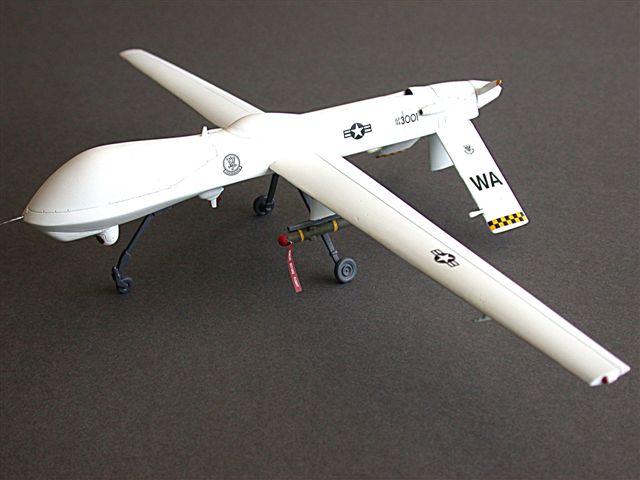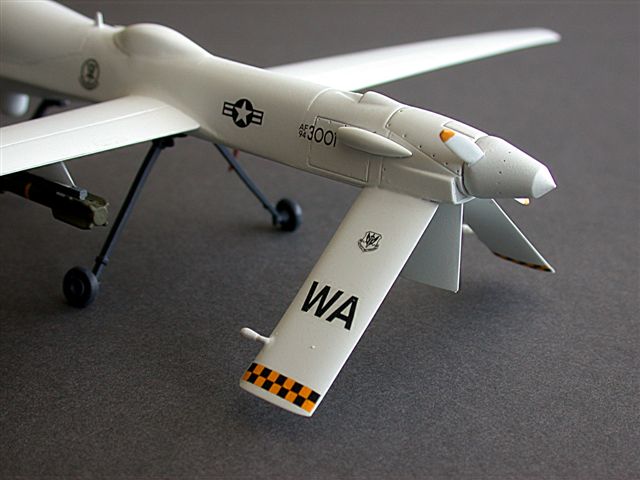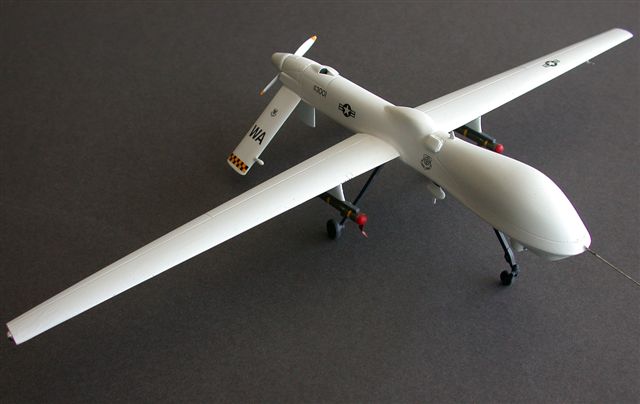|
Assembling the 1/48 AlphaFlight RQ-1 “Predator” UAV
"I Know Where You Live"
by
"Bondo" Phil Brandt
|

|
|
RQ-1 “Predator” UAV |

HyperScale is proudly supported by Squadron.com
Background
Your correspondent was so exhausted after his mortal battle with the Combat Mercator that the personnel shop at Bondo Industries insisted he go on R&R. Unfortunately, fuel prices have driven airfare to Pattaya Beach in Thailand (where thousands of Vietnam Era GIs R&R’ed) to prohibitive levels, so instead it was back to the Texas Hill Country and the ol’ El Rancho Loafo where the simple-but-expensive ($69.95!) AlphaFlight resin Predator had been in the stash for more than a year.
It would be difficult to find an aircraft subject more current than the RQ-1 UAV, designed and built by General Atomics. It has consistently been able to silently loiter in the skies of Iraq, as well as Afghanistan and its border with Pakistan, reporting the movements of and, with its Hellfire missiles, selectively eliminating “high value” Islamic Jihadist targets in areas some of which are virtually impenetrable to all but the most sophisticated U. S. assets. And, most interesting of all to this retired TAC puke, is that many of the Predator’s Middle East combat missions are being controlled from Creech Air Force Base (ex-Indian Springs Aux. Airfield) just north of Las Vegas on U.S. 95.

A personal aside: Creech Air Force Base is named for deceased General Wilbur L. “Bill” Creech, ex-Thunderbird and past commander of the Tactical Air Command. “The Creech-er” was known for his fastidious–some might say vain–attention to personal military appearance. While on an official visit to Mt. Home AFB circa 1978, he requested a Q&A session with younger officers. As a miffed, recent “passover” to Lt. Col. yours truly was “encouraged”, along with his fellow passovers–there were more than a few--to meet with the general. At the appointed time, the four-star sat alone on an auditorium stage, resplendent in his blue uniform, not a hair out of place, and gave us his version of “how goes it” in TAC and the world. When the time came to entertain questions, Boy WSO Bondo stood up and asked the general if he could offer any hope of promotion to us passovers who, just two years before had been assured that the new “1-2-3 “ (quota rating system–prior to the installation of this new scheme theoretically 100% of officers could “walk on water”) promotion system would take care of us when our time for promotion came. The general took his time in replying, and then told us in frank, measured words that we were essentially screwed. It was a serious moment, but I respected him for not sugar-coating the answer, and I mentally started planning the next half of my working life......in the civilian world.
The Kit
Note that the sub-head of this piece is titled “assembling”, not “building.” Tamiyagawa weekend Bf-109 clones got nuttin’ on this all-resin“shake and bake”! A total of no more than twenty-eight exceptionally smooth, very cleanly molded parts–no cockpit to worry about–make up the whole shootin’ match. Fit is excellent also, with just a small seam to putty where the aft portion of the top and bottom fuselage halves join. The only size discrepancy is where the spinner of the Rotax engine fairs in to the aft fuselage; the spinner diameter is slightly too large and had to be trimmed.
Landing gear struts are cast metal (a small resin fork is used in the nosegear), require minimal cleanup and are easily bendable to alter the gear stance, and thereby the C/G, for balance. Wheel/tire assemblies are resin.

Three versions are possible: Air Force (11th reconnaissance Squadron; the version I chose), Navy and Italian (!). Yes, this curmudgeon must be in the 5% of those who never got the word that five overall gray Predator airframes are currently in use by Italy. A few kit options are offered, and I chose to add the over-the-wing saddle tank for those long “sandbox” missions and the very noticeable forward housing containing the FLIR, synthetic aperture radar (SAR) and color video systems.
Weapons
Although resin Hellfire halves (with separate launch pylons) are included in the kit, I avoided the hassle of having to sand and fit the resin halves, instead opting for one-piece Hellfires from a Hasegawa Longbow Apache. “Remove Before Flight” tags by Eduard.
 El Supremo Tamiya white lacquer spraycan primer to the rescue again, as primer and color coat; I love ths stuff! The pigment is so fine that a semigloss texture results, and decals can be applied directly, sans clearcoat. El Supremo Tamiya white lacquer spraycan primer to the rescue again, as primer and color coat; I love ths stuff! The pigment is so fine that a semigloss texture results, and decals can be applied directly, sans clearcoat.
A light dusting of well-thinned Testor's flat clear acrylic helped the decals blend right in to the white airframe background.
Another reason I chose the USAF version is because I always liked the black-and-yellow checker motif of the Nellis-based 57th Fighter Weapons Wing (“WA”).
A relatively easy project; I am surprised no one has done a 1/48 scale injected version.
And now, back to the mean streets of the Bondo Industries Difficult Kit Division...
- HALE/MALE Unmanned Aerial Vehicles Part 1, International Airpower Review, Vol. 15, ISSN 1473-9917 / ISBN 1-880588-86-2
Model, Images and
Text Copyright © 2008 by "Bondo" Phil Brandt
Page Created 25 August, 2008
Last Updated 25 August, 2008
Back to HyperScale
Main Page |
Home
| What's New |
Features |
Gallery |
Reviews |
Reference |
Forum |
Search